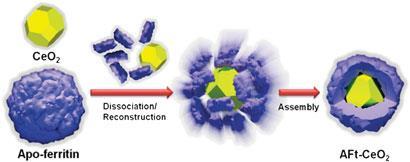An antioxidant wrapped in a soft protein shell could be a treatment for a nerve cell disease
Scientists in China and the US have fabricated an artificial enzyme that may provide new hope for the treatment of Lou Gehrig’s disease. Lou Gehrig’s disease, or amyotrophic lateral sclerosis, is a condition that affects brain and spinal cord nerve cells responsible for controlling voluntary muscle movement.
The cause of the disease is oxidative damage to cells by incomplete removal of reactive oxygen species (ROS). Ding Ma from Peking University and colleagues made an apoferritin-CeO2 nanocomposite that clears these harmful reactive oxygen species and found that they are more efficient than the natural antioxidant enzyme superoxide dismutase (SOD), which is present in all cells.
The team recognised that to develop an active and biocompatible ROS scavenger, they needed to combine a highly antioxidant species with something that would be readily accepted by the target cells. So, they encapsulated the antioxidant nanoceria inside the cage protein apoferritin (AFt). The team broke apart apoferritin’s soft shell and wrapped it around the hard nanoceria core in what they call a dissociation-reconstruction process.

In tests, the nanocomposite species was able to clear over 70 per cent of ROS in a sample, while SOD only quenched around 20 per cent and CeO2 alone quenched just 10 per cent. This increase in activity for AFt-CeO2 is down to charge transfer at the bio-organic interface which, according to Ma, is the ’most unique feature’ of the ROS scavenger. AFt-CeO2 also vastly outperformed non-encapsulated nano-CeO2 in tests on liver cancer cells as well as showing increased uptake and markedly reduced toxicity.
For potential healthcare applications, ’the biocompatibility is a big bonus’, according to William Self, an expert in nanoceria particles and their use as antioxidants at the University of Central Florida College of Medicine, US.
Ma is convinced that the structures ’have great potential in the treatment of some specific types of incurable disease’.
Andrea McGhee
References
X Liu et alChem. Commun.






No comments yet